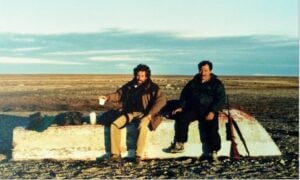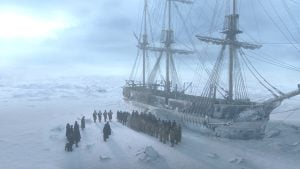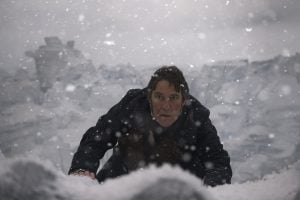It’s been 173 years since the Franklin Expedition departed England to locate a Northwest Passage, only to fail in the most disastrous, miserable way possible. The story of the expedition and what, precisely, happened to its 129 men has long been a subject of fascination for historians and explorers, but it has also generated a considerable number of artistic works — plays, poems, songs, books, films and paintings among them.
The latest addition to the Franklin cultural canon is The Terror, AMC’s 10-episode series based on the 2007 novel by Dan Simmons. The show, starring Ciarán Hinds, Jared Harris and Tobias Menzies, premiered tonight, much to the delight of Russell Potter and Stephen Smith, both of whom are aficionados of all things Franklin and will be reviewing each episode of the show for Canadian Geographic. Their takes on this evening’s double-episode premiere appear below.
Russell Potter
For those of us who’ve been researching and re-evaluating the story of the loss of the Franklin expedition for years, AMC’s new series The Terror resonates rather differently than it probably will for the average viewer. Back in 1993, in an interview with the CBC’s Carol Off, Margaret Atwood made an apt prophesy:
This story can still evolve — we may find out more, or people may come up with other ideas or other interpretations. After we’ve had “Franklin the dope” for a little while, undoubtedly we’re going to get a different Franklin; people are going to say he wasn’t such a dope, really he was a mystic — or something.
Something, indeed. Though portrayed in the past as stoic and cheerful (2004’s Arctic Passage), timid and bumbling (John Walker’s 2008 Passage), or chisel-chinned and merely unlucky (2015’s Arctic Ghost Ship), The Terror gives us a very different Franklin indeed. He’s no mystic, but he’s no milquetoast either; in Ciarán Hinds’s portrayal, he’s confident, cocky, even careless of the health of his crews. His evident hubris is contrasted with the cold caution of his second, Francis Crozier, vividly brought to life by Jared Harris. Harris’s Crozier has a bleakness, born from hard experience, and tinctured by personal disappointment, but he hasn’t entirely lost track of his humanity. When, as the fateful decision about which side of King William Island to sail the ships is about to be made, he utters his own dark rebuttal, couched in an Irish subjunctive: “Our situation is more dire than you may understand.”
And of course it is. Even the viewers for whom this story is entirely new will know from the first scene, where an unnamed Franklin searcher questions a Netsilik Inuk about “Aglooka,” said in the oral testimony to be the last man standing. The Inuk identifies Crozier from his Daguerreotype (a lovely touch), then tells his listeners that this man was dying, warning away others, pursued by some shamanistic creature made of “muscles and spells.” He underlines his testimony by scattering a few naval buttons over Crozier’s likeness — these are all that is left of the man.
Moving back to 1846, when those buttons were still on their uniforms, the rest of the first episode establishes the drama, and it’s as dark as their navy broadcloth in the dim-lit ship’s wardroom. The tensions between the men are sharply drawn, and portray a scene far harsher than the genial conviviality the actual officers described in their last letters home the year before. Of course, the Arctic may do that to a man, and already the omens are ill; besides the three men buried at Beechey Island in the first winter, others are sickening, vomiting blood, wasting away. And that’s only the natural peril, not to mention the supernatural one that, hinted at here, lurks in the shadows of episodes to come.







